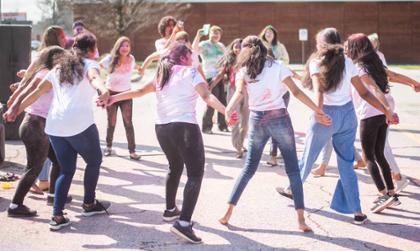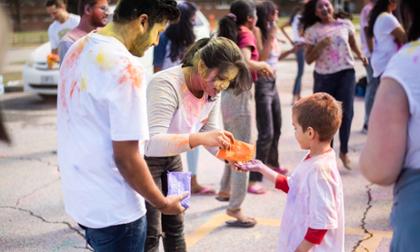“It is a great chance for Americans to experience the Indian culture right here in Pittsburg, without travel, and for our Indian students to get to mingle with Americans,” said Prince Lathiya, a Math major from the city of Surat and vice president of the Indian Student Association.
There are 179 Indian students enrolled at Pitt State this semester. The celebration, Holi Festival of Colors, is an ancient one in their culture. It dates back thousands of years and is now celebrated around the world.

In India, the timing of Holi is synchronized with the moon, which means that the actual dates vary from year to year. Holi typically falls on the full moon day (Purnima) between the end of February and the middle of March (month of Phalgun), according to the Hindu lunar calendar.
On Friday at Pitt State, it will be held from 4 to 8 p.m. in Lindburg Plaza, the area between Gibson Dining Hall and McCray Hall that forms a courtyard.
“It’s a celebration of new beginnings,” Lathiya said. “It is characterized by joy and color, and everyone is welcome.”
It’s also characterized by the tradition of throwing colored powders and water on one another; those who attend are advised to wear a white T-shirt and old shoes.
Each color is representative of an important meaning in Indian culture, explained Jyothisree Gundapaneni, a Construction Management major from the city of Vijayawada and president of the Indian Student Association.
“There will also be dancing to traditional Indian music in a big circle, which is a lot of fun. It is our way to welcome Spring,” she said. “Just like we are here to experience your culture, we want you to experience ours, and we hope to have lots of families and individuals join us.”
Alexandra Robinson, a Biology (Pre-Med) major from Pittsburg, said she had a lot of fun at last year’s event.
“The dancing in such a large crowd was very uplifting, and it was fun to throw around the colors,” she said. “It was definitely a unique experience."

Depending on regional traditions, Holi can be a two-day festival or an afternoon celebration. The first evening is known as Chhoti Holi (small Holi) and usually involves a symbolic bonfire as people gather to sing and dance in hopes of overcoming negativity by getting rid of bad thoughts and deeds from the previous year.
On the next day, people of all ages wear white to throw colored powder (gulal) or colored water (pani) at one another. In the evening, everyone gathers with their family and friends to enjoy festive foods, sweets, and companionship.
With a theme of harmony and new beginnings, Holi encourages people to forgive and forget — to pay off old debts, renew broken relationships, and make new friends.
In the northern and rural regions of India, Holi celebrates the beginning of Spring harvest. For many in farming communities, Holi signals the end of winter hardship, which comes with low temperatures, unsuccessful crops, and inadequate shelter to deal with the cold months of the winter season. As many people in India harvest their wheat in the spring and since there are community elements to Holi, some people liken it to it the American tradition of Thanksgiving.
For others, it aligns more closely with the Jewish tradition of Passover due to the themes of renewal and starting fresh.
The significance of Holi comes from a special process in which gram, wheat, and other grains are roasted, together. This special blend is called holuk, hence the name Holi. On the eve of Holi, it is customary to light a bonfire and roast grains and corn as an offering for eating and promoting a feeling of companionship and a sense of community among those who are celebrating.
It is also said that the word Holi comes from the Hindi word ‘hola’ which means to offer sacrifices or prayer as thanksgiving for a good harvest.
Learn more about being an international student at Pitt State: